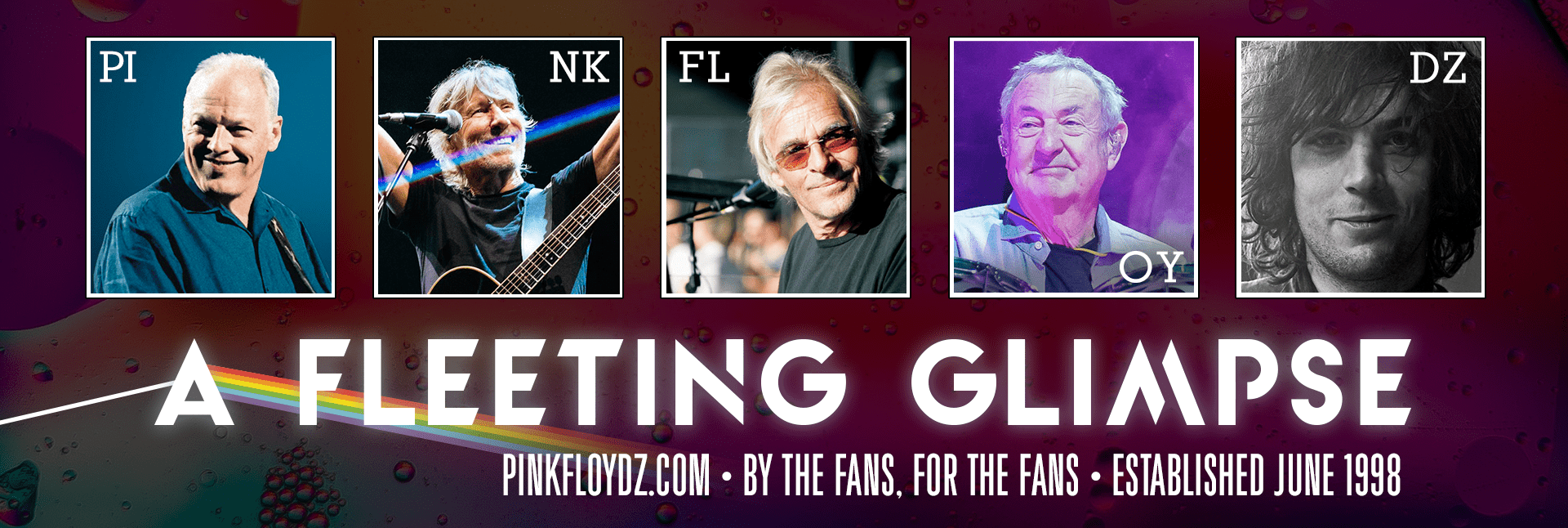Q Magazine April 1998.
(Transcript thanks to Natalie Lyons)
LUNAR TUNES
The songs had sold 120,000 on bootleg before Pink Floyd officially recorded them and it remains your favourite album of the decade. Still confused by the unusual aroma of his mate’s older brother’s copy, Mark Blake wrestles with the Timeless Appeal of Dark Side Of The Moon.
Never mind the music, it was the cover that got you interested. For anyone coming to Dark Side Of The Moon in the late 1970s (it was still in the charts, nearing the end of a healthy 337-week run) its spooky, minimalist sleeve sent out all kinds of messages. Against the modish look of Elvis Costello’s My Aim Is True or The Jam’s This Is The Modern World, Dark Side’s triangular motif and accompanying rainbow were synonymous with a musical stone age, at best ignored, at worst derided. However, to young – let’s be frank now – ELO fans, with a sneaky regard for music made before 1977 – not a popular stance in the days when rock music history was busily undergoing as Stalinist re-write – it promised all sorts of scary, grown-up delights.
Those old enough to have bought it when it came out in 1973 were already in on the secret. But who were they, and what 13-year-old ever spoke to anyone three of four years older than them? Thus, to musically inquisitive adolescents Dark Side Of The Moon was the ultimate “older brother’s album”. It was somehow different. For starters, it actually smelled different – although it was some years before the sweet, strangely herbal odour emanating from a mate’s older brother’s copy was to be identified – there were no pictures of the band to be found anywhere on its gatefold sleeve, and you never saw Pink Floyd on Top Of The Pops; reason enough at that time to doubt whether they even existed. Normal kids didn’t care and went on playing Darts’ Daddy Cool. The rest, undeterred by the non-communicative grunting of older siblings and a conspiratorial wall of silence in the music press, set about trying to hear this mysterious, aromatic album.
Dark Side Of The Moon continues to shift – 29 million at the last count – and Q readers recently placed it at number 10 in their Top 100 albums of all time. Its appeal seems constant, while artists as diverse as Radiohead and The Orb blithely namecheck the group as an influence.
Part of its initial success must lie in the fact that it was a good deal more inviting that most of what was around in 1973. Those with nerves of steel should play it back to back with Emerson Lake & Palmer’s Brain Salad Surgery and Jethro Tull’s A Passion Play – big-news progressive rock albums from the same year. The difference is embarrassingly obvious. Pink Floyd’s own track record was not unblotted by wanton self-indulgence, but they reigned themselves in this time around.
By now, band members David Gilmour, Roger Waters, Rick Wright and Nick Mason were in their late twenties and early thirties and their unwashed hair and face fungus remained the only tangible links with what might once have been called “The Underground”. Bringing a white-collar, almost clerical discipline to the task in hnd, they plotted every stage of a record they had already hewn thoroughly on their ’72 tour (and heavily bootlegged). Despite its concept album tag, Dark Side contained songs of both a manageable length and discernable structure. “We wanted to come down to earth a bit,” offered bassist/songwriter Roger Waters. “I had something I definitely wanted to say”.
So while Emerson Lake & Palmer were busy whisking up a baroque soufflé, Floyd came up with Breathe, Time and Us And Them – Robert Johnson in comparison – segueing everything with the futuristic warble of VCS3 synthesisers and a collage of background noises: a human heartbeat, cacophonous alarm clocks and the mumblings of Jerry Driscoll, the Abbey Road doorman. Not to mention great, deeply bluesy guitar solos that never outstayed their welcome. Implausibly, considering the cold, soulless acts they were lumped in with (anyone for Van Der Graaf Generator?), The Great Gig In The Sky, with its vocal gymnastics from session singer Clare Torry, added a gospel fervour to proceedings, while Waters’ lyrics told a story of madness, disillusionment and general pissed-offedness – hot stuff for teenagers of any age and decade.
Released at a time when hi-fi was becoming increasingly advanced, the album gave record buyers the chance to show off their “stack” while offering hours of listening pleasure when the headphones went on. “It still doesn’t sound dated,” agreed guitarist David Gilmour. “But I really don’t see why it should achieve that longevity over some of the other great records that have been out.”
The reason for its success isn’t so difficult to gauge. Dark Side has offered something different to a succession of new audiences: be it On The Run’s synthesised pre-rave doodlings, the perfect chill-out room vibe of Time, or the Sturm und Drang heavy metal of Money. There are few displays of musical virtuosity – Jonny Greenwood shows off more on Radiohead’s OK Computer than David Gilmour does over 16 Pink Floyd albums – and the rejection of an anachronistic sleeve shot depicting the band with waist-length hair and oily loon pants, remains, in retrospect, a genius move.
And, of course, there’s still that cover. While their peers were busy commissioning a veritable Sistine Chapel of dragons, space ships and pixies in stovepipe hats, Pink Floyd kept it simple, striking and ultimately timeless. No wonder everybody’s older brother wanted to keep it to themselves.
